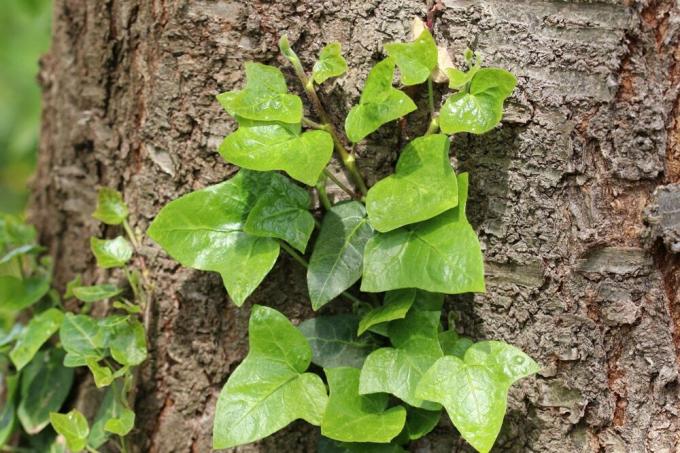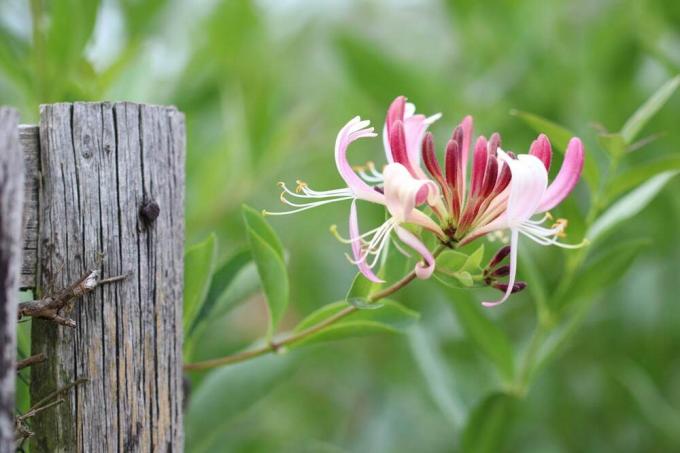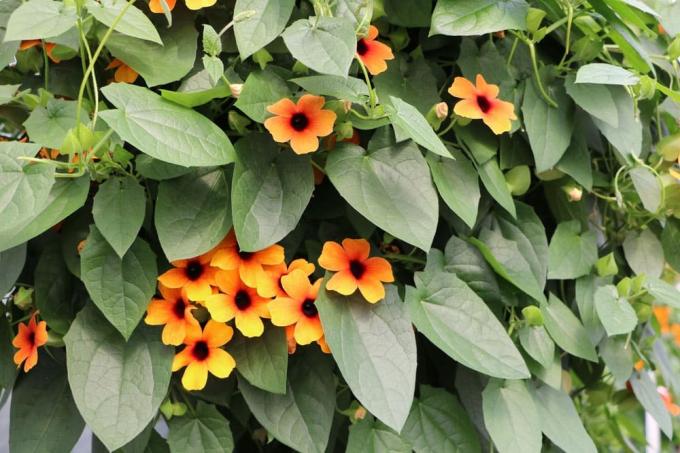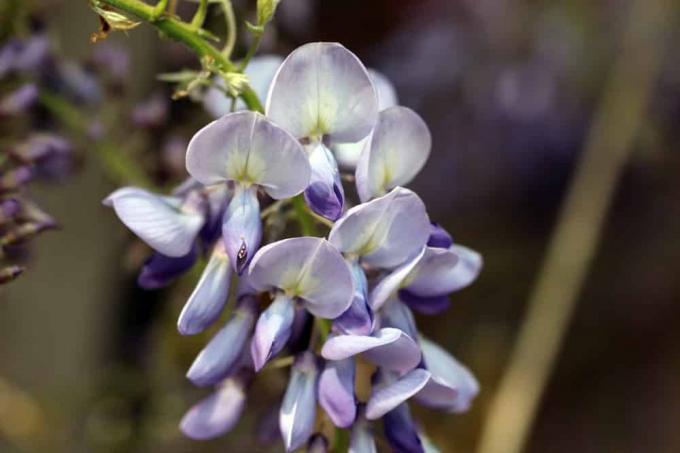

Table of contents
- ivy
- Climbing spindle shrub or creeping spindle
- honeysuckle
- passion flower
- Wild Wine
- winter jasmine
- climbing hydrangea
- Wisteria
- hop
- climbing roses
- Trumpet Flower, Trumpet Morning Glory
- clematis
- Interesting facts about climbing plants
Climbing and creeping plants ensure a contemplative and cozy ambience and sufficient privacy in summer. Another benefit of such plants is the sun and wind protection they offer. Climbing plants are suitable for any garden size or house wall. Due to their winter hardiness, they radiate a special garden romance all year round. If you want to enjoy the beauty of the evergreen climbing plants all year round, you should pay close attention to the site conditions. Because only when a plant feels good all around can it thrive magnificently.
ivy
The evergreen classic plant can climb an entire wall with its fantastic green. With the help of the adhesive roots, the ivy provides the necessary support, but also leaves the so-called fingerprints on the house wall if the masonry should be freed from the ivy again
- west or north facing wall as location
- acidic soil should be avoided, otherwise the ivy is very adaptable
- no soil compaction
- Soil should always be a little moist
- must be watered regularly even in winter
- easy pruning
- Trellis required from about ten meters, but advantageous
- particularly frost-resistant
- rapid growth, approx. 2 meters per year
- can grow to a height of 25 meters depending on the variety
Climbing spindle shrub or creeping spindle
An evergreen climber with clinging but shallow roots.
- location in full sun, but also partially shaded or fully shaded; the plant is also suitable for more shaded areas such as a north-facing wall
- it is very adaptable, but needs sufficient moisture
- no soil compaction, a sandy, humus-rich soil is beneficial
- Avoid long droughts of the plant, especially when it is hot, otherwise the leaves will drop in autumn due to lack of water
- it tolerates pruning and can be cut back two to three times a year
- a trellis is not absolutely necessary, since the plant has adhesive roots and only grows at a low height
- the shoots can be attached with commercially available modeling wax, but you should be careful because the shoots can also grow into joints
honeysuckle

A likewise evergreen climber and a twiner. It is an excellent alternative to ivy. A lack of water can be recognized by curled leaves. This serves as self-protection and against too much evaporation through the leaves.
- sunny location with semi-shade
- fresh, moist and nutrient-rich soil
- Flowering period from June to August with yellow-red flowers, followed by small, round, blue-black berries
- can easily be cut back in spring
- use net-shaped aids or vertical fans as climbing aids; Branches and transverse elements are important here, since the honeysuckle is a twiner with medium-strong growth
- annual growth of 30 – 60 cm
- growth height of 8 m
passion flower
The hardy, climbing passion flower is also perfect for embellishing fences, climbing wire or obelisks. Their exotic flowers spread a certain flair throughout the summer. It does not form any adhesive feet and thus leaves the masonry undamaged. However, she needs a climbing aid with which she climbs spirally. Although it has a tropical origin, it is easy to care for and undemanding. As a container plant or in a garden bed, it is a special eye-catcher and a feast for the eyes.
- sunny to partially shaded location
- Distance to other plants at least 50 to 60 centimeters
- medium to high water requirement
- low maintenance
- Growth height up to 150 centimeters
Wild Wine

It is a hardy climber and adherent root and is particularly popular for its bright and pretty fall color when its leaves turn bright red.
- sunny to partially shaded location
- strong growth with a growth height of between ten and twelve meters
- normal garden soil is sufficient
- robust and easy to care for
- wind tolerant
- Climbing aid is helpful but not necessary
winter jasmine
A scrambler and evergreen climber that thrives free-standing into loose and low yet strongly overhanging shrubs. As a herald of early spring, it looks particularly beautiful on walls. It is easy to keep in pots on balconies and terraces.
- sheltered semi-shady to sunny location
- permeable and nutrient-rich soil
- Pruning every two to three years, which should take place in the spring after flowering
- Up to 2 meters high when using a climbing frame
- Flowers 2 to 3 cm in size, which can bloom as early as December.
climbing hydrangea
It is also a clinging root, but still needs a climbing aid in the first year. Then she climbs up walls, trees and pergolas completely independently. It convinces with beautiful shiny dark green leaves. In addition, it grows very luxuriantly.
- it does well in sunny or semi-shady locations
- Flowering period from June - July with a white, flat, fragrant and umbrella-like flower
- their growth height is between 3.5 and 5 meters
- normal garden soil is sufficient
Wisteria
Also known as wisteria, it is a very popular plant in local gardens. The wisteria is a very beautiful flowering climber, is considered a twiner and grows fast and strong. It is suitable for covering facades, house corners, pergolas and arbours.
- sunny location
- Flowering period from May to June
- growth height approx. 10 m
- Climbing aid is required
- quite undemanding as far as the condition of the soil is concerned; nevertheless, sandy-loamy soils are very suitable
- adequate water supply is required
hop

The hop is a twiner and a fast-growing climber. This means that if you want your objects such as pergolas or house walls to be covered quickly, choose the hops.
- a sunny to semi-shady location benefits growth
- the flowering period with light yellow flowers is from June to September
- a strong growth up to 10 meters in height
- the soil should be nutrient-rich and moist
climbing roses
The queen of flowers is also available as a climbing variety. Depending on the genus, roses that bloom once a year and others that bloom more frequently are available. Arches, fences or trellises can be decorated with the climbing roses. Likewise, pergolas or arbors can be covered with them. With a growth rate of 1.5 to 5 meters, it is also well suited for smaller wall areas.
- Southeast or southwest walls are suitable as locations
- loamy soil, supplied with humus, but without waterlogging
- the soil is always sufficiently supplied with water and nutrients
- in winter, the plants need winter protection at the foot, this can be done with brushwood or spruce branches
- pruning is done every one to two years, either in late winter or before the start of spring, always after the heaviest frost
Trumpet Flower, Trumpet Morning Glory
She is a root climber and a true climbing artist. It impresses with its beautiful orange flowers that are trumpet-shaped, which also explains its name. It also has lush green leaves. A climbing aid is only necessary on very smooth walls.
- full to sunny location
- Flowering period from June to September
- any normal garden soil is sufficient for it to thrive
- pruning may only be done in spring.
- it easily reaches a height of eight meters
clematis
Clematis is a petiole climber and a beauty in its own right. They come in different types and colors. A planting on the terrace in pots or other containers as well as on the balcony can be perfectly designed with the clematis.
- a sunny to partially shaded location
- the flowering period is from May to September
- Humos soil
- The shading of the foot - the lower 20 to 25 cm - of the clematis has an advantageous effect, this can be achieved with ground cover or decorative perennials
- The pruning should take place in the first year between November and December
After that, different pruning regulations apply depending on the type of clematis plant
Interesting facts about climbing plants
are particularly ideal Climbing plants for small gardens. There they can grow in height instead of in width. So you can accommodate many different plants even in small areas.
Perennial climbing plants are also well suited for greening house facades.
facade greening aesthetically enhance buildings and ensure a balanced living environment. They also protect the masonry from the weather. However, you have to be careful with self-climbers, who climb directly up the wall with adhesive organs. To avoid unpleasant surprises, you should always attach a support structure for the plants. There are extensive kits and climbing aids for all purposes.
Perennial climbing plants usually do not need much care. They need sufficient water and regular fertilizer during the main growing season. You have to trim them regularly though. A flower will only appear if the buds are stimulated to bloom by pruning. Strongly growing, sprawling shoots should be cut back to the cones, i.e. above a strong bud. The many two to three year old thin shoots can be removed. Larger, spreading branches should be reduced with a saw if necessary.
 garden editorial
garden editorial I write about everything that interests me in my garden.
Learn more about climbing plants

Is black-eyed Susan poisonous?
Black-eyed Susanne can delight all of our eyes with colorful flowers. But if small children or pets are around it, it is important that we also clarify whether it is possibly poisonous. The answer to that is clear and a little surprising!

Black-eyed Susanne, Thunbergia alata: Care from A – Z
Black-eyed Susanne is one of the most popular climbing plants. It is ideal for greening house walls, balconies, fences and pavilions. If you follow our care tips, you will enjoy the splendor of their flowers.

How fast does wisteria grow? | Information about growth
As its name suggests, the wisteria, as an intensive climber, enriches walls, trellis structures and other possibilities for spreading a magnificent, glowing blue sea of flowers. You can find out what you should consider when growing with us in a simple and understandable way.

How fast does Virginia creeper grow? | Information about growth
If you want a trellis or a house wall to be lushly greened, you will find a grateful partner in Virginia creeper. Over time, it can grow into large areas and, especially in autumn, enrich it with colorful foliage. Contact us for helpful information on growth.

Evergreen honeysuckle: care from A to Z
The evergreen honeysuckle is popular for greening walls or fences, because the creeper is green all year round and has beautiful delicate flowers. Although the honeysuckle is not very sensitive, it needs a minimum of care for it to develop well.

How fast does ivy grow? | Accelerate growth effectively
Ivy (Hedera helix) is a true climber that climbs up walls and house walls without any problems and can have a very decorative effect. Once it has taken root, it can literally overgrow large areas in a very short time. You can literally watch him grow.



